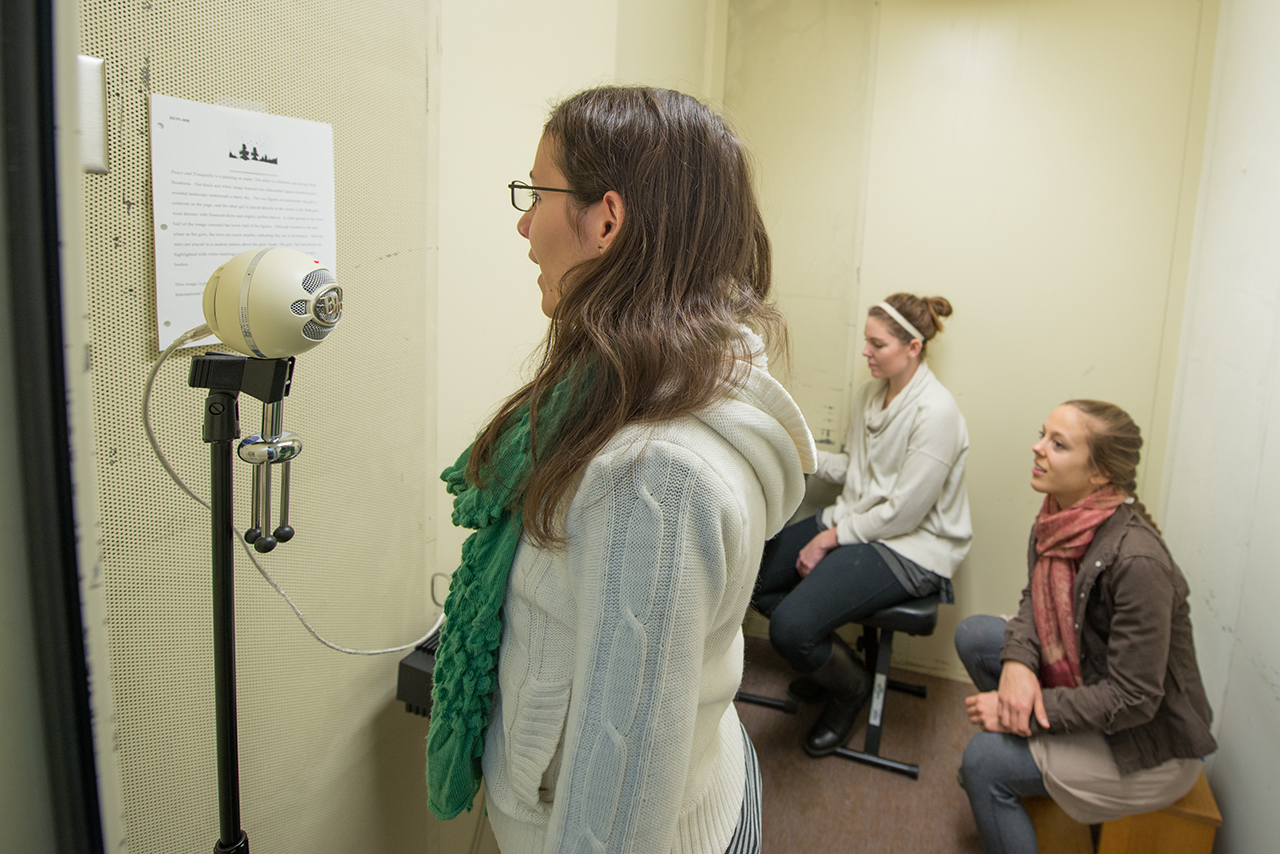Milner Library is home to one of the most impressive collections of children’s art in the world. With over 8,600 pieces of artwork collected from over 50 countries, the International Collection of Child Art provides valuable insight into different cultures and offers a glimpse into the way children think and express themselves.
It’s a resource that benefits study in childhood development, art, anthropology, education, and many other fields. But if a scholar from any of these disciplines wanted to benefit from the collection, the images would need to be seen.
This is a barrier that would seem insurmountable for a person with a visual impairment.

Milner Library librarian Kathleen Lonbom (second from left) is working with student researchers to digitize the library’s International Collection of Child Art.
Milner Library’s Art, Theatre, and Dance librarian, Kathleen Lonbom, M.F.A. ’84, has been working to make the International Collection of Child Art available to everyone, including those who are fully or partially blind.
A few years ago, Milner received an $85,934 Library Services and Technology Grant from the Institute of Museum and Library Services to digitize the Child Art Collection. Around the same time, the Illinois Information Technology Accessibility Act, passed by the legislature in 2007, provided the initiative to make images available to those with a visual impairment.
Rethinking how the collection could be used by those with a visual impairment gave Lonbom, who has a background in visual arts, the occasion to reassess what was possible for Milner’s collections.
“This was a really new concept to me. And one that made me really stop, pause, and think very deeply about what it was we were going to do with this collection,” Lonbom said. “This was something I had to learn.”
“It was always fun to see how everyone interprets the pieces differently. This was also helpful to come to understand the importance of every descriptive word.”
—Anna Jahncke
To comply with state guidelines, Lonbom discovered the library needed to develop audio descriptions of each newly digitized image. But what would those descriptions say? And how should those descriptions sound?
Lonbom was given a half day of training from the state of Illinois on the basics of creating accessibility for the visually impaired. Harder to pin down was how to express the nuance of a piece of visual art through audio. Describing images such as maps or historical photographs is one thing. Conveying the vibrancy present in a 6-year-old’s watercolor is something a bit more complex.
“My training didn’t stop with the state. Actually, the thing it did was make me hungry for more knowledge about how to create this avenue of accessibility,” Lonbom said.
A pursuit of additional training at the Kennedy Center’s Leadership Exchange in Arts and Disability Conference workshops introduced Lonbom to a community that works with audio descriptions.
Over the course of the last several years Lonbom has engaged in research to investigate ways to present Milner’s images to the blind. Included was a pilot project to investigate the development of effective audio descriptions.
To assist with the research, students majoring in education, art, technology, special education, English, and psychology participated in project groups. The team, aided by a Milner digital imaging specialist, Erica Holden, who has a background in audio production, wrote descriptions and recorded them in a sound booth located in the library.
The student research assistants reviewed each other’s drafts in written form and critiqued the language and what it would mean for someone with partial or total blindness.

Anna Jahncke (left) and Whitney Johnson have been participating in a Milner Library research project that has been creating audio descriptions of works in the International Collection of Child Art.
Alzbeta Homolkova, a senior psychology major who worked in a project group last year, found that the review illuminated the challenges of interpreting a visual medium. Looking at a child’s drawing of a figure as an example, Homolkova noted, “One person would say, ‘That person looks like they are happy.’ Another person would say, ‘They look cold.’”
One technique involved testing the audio description with a student to whom the picture was unknown. The student who hadn’t seen the image would try to draw a re-creation of the artwork having only the description as a resource.
“It was always fun to see how everyone interprets the pieces differently,” said Anna Jahncke, an art education major who worked in one of the project groups. “This was also helpful to come to understand the importance of every descriptive word.”
As some of the images in the collection were four decades old, and from a variety of countries and cultures, the project groups needed to do research to make sure to capture the context of the piece of artwork.
Once the descriptions passed the test of the review process, the audio descriptions were recorded and the images were posted in an accessible format online.
With the click of a mouse, the visually impaired were now able to hear what others were able to see.
Not only has the project enhanced Milner’s digitized Collection of Child Art, but the process of creating the audio descriptions has proved to be a valuable learning experience for students.
“I would love to see this be part of the curriculum at the graduate level,” Lonbom said. She said if students were tasked with the exercise of creating accessibility options for visual media, the process would make a lasting impression.
“Taking into account the low vision/blind population, would just become standard,” Lonbom said. “It would become routine. There are fascinating directions technology is taking image description. Both Google and Stanford University have developed models that generate natural language descriptions of images. The potential is quite exciting.”


